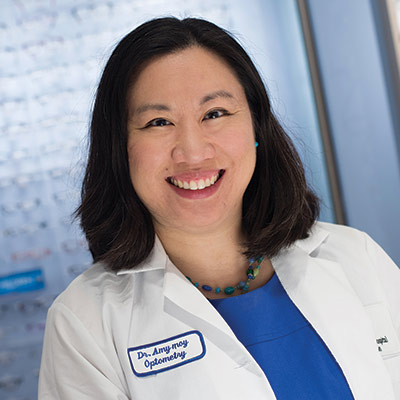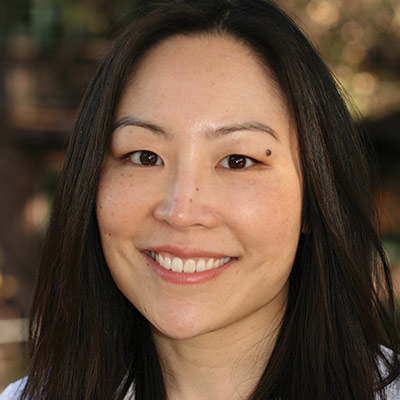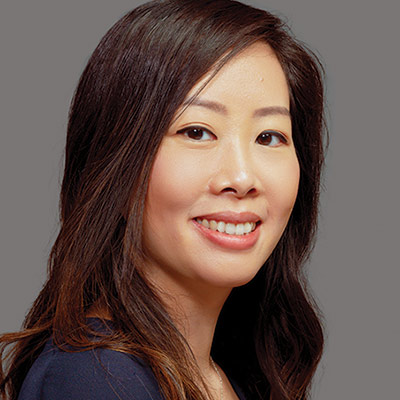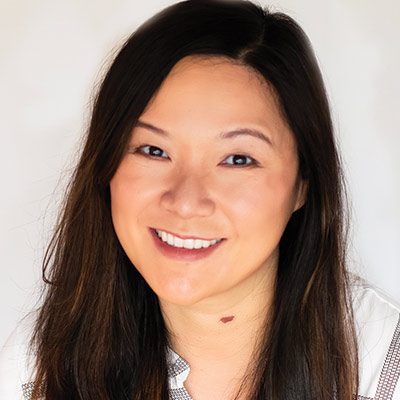By Marjolijn Bijlefeld
With the recent surge of violence against the Asian and Asian American population in the U.S., Women in Optometry sat down with a group of Asian American ODs to speak on their experiences; varied and strikingly similar. Participants were Amy Moy, OD, FAAO, CPCO, Director of Health Center Network and Chief Compliance Officer at the New England College of Optometry (NECO); Kerri Yoshiyama, OD, FAAO, from the University of California, Berkeley School of Optometry; Linda Pham, OD, FAAO, also of NECO; Joyce Chien, OD, who works in a corporate-affiliated practice in Chicago, Illinois; Meng Meng Xu, OD, FAAO, from NECO; and Hardeep Kataria, OD, FAAO, who works at a retina practice in Oxnard, Calif. None are strangers to the ugliness of racism and biases, but following the mass shooting at a spa in Atlanta, Ga., earlier this year, they and many others with Asian American and Pacific Islander (AAPI) heritage have explored their own memories of racism, while asking themselves how they can help to make the world a better place for the next generation.
Many of the doctors are children of parents who came to the U.S. Dr. Moy, a Taiwanese American born in the U.S., recalls an experience familiar to people of different cultures: bringing a packed lunch to school and being asked, “What is that?”

“I had a feeling I was different very early on,” says Dr. Moy. After hearing that her daughter was facing teasing and bullying, Dr. Moy’s mother would come to her elementary school and give immersive presentations on Asian culture—complete with origami, dumplings and a lesson on how to use chopsticks. Now, Dr. Moy looks back in admiration. “I realize she was empowering people back then,” she says.
A descendant of Japanese immigrants who arrived in the U.S. in the 1800s, Dr. Yoshiyama’s third-generation American parents lived through World War II in the U.S., where her father spent some of his boyhood in a Japanese internment camp. Her maternal grandfather refused to go, so he packed up the family and drove as far as Colorado, where he was refused gas to refill his car. Dr. Yoshiyama’s grandparents, scarred by their own experiences, began to distance themselves and their children from their cultural heritage with the hopes that assimilation into the U.S. lifestyle would make them stand out less.

While Dr. Yoshiyama’s Bay Area school system was comprised of approximately 50 percent Asian students, it didn’t stop the microaggressions and the insidious racism that crept its way into her life. “It hurt somewhere deep down, but it wasn’t the place to advocate for myself,” she says. “In Japanese Buddhist culture there’s a word; gaman,” says Dr. Yoshiyama. (written in kanji as 我慢). “It means you should bear it; be grateful, because your plight is less than what your parents and grandparents had to go through.” While there may not be an exact English translation, the word, simply put, means “enduring” or “persevering.” This concept is a common through line for Asian American doctors.
FEELING INVISIBLE,
PERPETUAL FOREIGNERS
A feeling of being overlooked was another shared experience for the women. “You always feel like you’re invisible,” says Dr. Xu. “People say hi to the person I’m walking with or assume I don’t speak English.” Dr. Xu grew up in Montreal, Canada, and is a polyglot, fluent in French among several languages. “People say, ‘How do you know French?’ I’m from here! I grew up speaking French!” Dr. Xu heard the same questions as the other doctors: “Are you a refugee? Do you know how our televisions work?”

Dr. Chien and her family moved to Greece for a year—a nation with a small Asian population. While there, she had the disheartening realization that she felt right at home… being a foreigner. “In Greece I was a foreigner, but in the U.S. I’m not. It just [didn’t feel] that different to me.” “We tend to be seen as perpetual foreigners, even if we were born here,” says Dr. Pham, who is Vietnamese-American.
ENOUGH IS ENOUGH
In their educational and professional circles, each of these doctors can detail encountering biases—both cultural and gender-based. “To be a doctor of Asian descent during a pandemic when Asians are being blamed is a very heavy weight to carry,” says Dr. Pham, referring to not only the fear of contracting COVID-19 and giving it to her family but also the worry of her elderly parents’ safety from racially-driven assaults.

When she was a resident, Dr. Kataria had a patient tell her they were sick of seeing non-American doctors, berating her with racist remarks. “I didn’t tell anyone, I just trembled through the exam. I walked out and internalized the fear and anger that I felt,” she says. Now, she is determined to make the future for optometrists of color and female one where they can comfortably come forward with their experiences. During her year as an assistant professor at Western University, Dr. Kataria had students nervously come to her, worried that their confiding in her would negatively affect their grade.

These continued bumps and slams into the wall of racism have pushed many of the doctors to decide to put their foot down. “Two months after the pandemic started, I said, ‘I’m done,’” says Dr. Kataria, who discharged a patient for his racist remarks after confronting him bluntly.
Dr. Moy agrees, noting that she now takes the opportunity to let people know socially and at work that jokes or microaggressions or even unintentionally provocative remarks are not OK. “Now I can say, ‘You really hurt me. I feel like you are minimizing my contribution,’ and that’s big for me because I was raised not to make trouble, to keep my head down and just do the work,” she says. “I have now been asking my fellow optometrists to amplify our voices, by pointing out great work done by the quiet ones who don’t make trouble, but who have not had much recognition for all that they do. I am asking fellow humans to stand up for others when they notice a microaggression by pointing out in the moment, ‘Hey, what you said made it seem like you were minimizing what our colleague here said. She actually has a great idea,’ or ‘Actually, that was so-and-so’s idea.’”
LIFE OUTSIDE THE OFFICE
We know, though, that racism doesn’t stop rearing its ugly head when people leave their jobs. Dr. Chien shares an emotional recollection of The New Yorker magazine cover she had just seen. “It showed two masked Asian females—a mom and a young daughter. The mom is looking away and the daughter is staying very close,” she sighs. “As an Asian mother, that’s how this is shaping me—how to protect my children.” In a time where parents already fear sending their children to school, movie theatres and public spaces due to mass shootings, Dr. Chien feels that stress at a much deeper level: “Are my kids going to be targeted specifically?”

Dr. Yoshiyama adds, “I have to teach my son about his duality and how that’s wonderful and powerful… but he has to be aware.”
The doctors describe the discouragement they feel at how little attitudes against people of Asian heritage have changed in this country. Some of the bias their parents—even grandparents—experienced still exists. “I don’t know if it’s going to change much or imminently,” says Dr. Kataria. “I look at our parent’s generation… I don’t know if we’ve made those steps.”
“I feel that helplessness, too,” says Dr. Moy. “We are all still processing our emotions while trying to make a difference.”
ALLYSHIP AND YOU
These doctors have been encouraged, moved by and often walked in the frontlines of the Black Lives Matter and Me Too movements. “It’s important to amplify the voice of the Black, Latinx, LGBTQIA+ [communities],” says Dr. Pham. She expresses the feelings of empowerment she has felt since witnessing people at Black Lives Matter and Stop Asian Hate rallies, who may not be personally affected, but choose to be allies.
For Dr. Yoshiyama, there is a lesson in the unrest of the past years. “We can raise our voices for ourselves, our families, but also for those who come after us.”
Still, as the old adage goes, the road to hell is paved with good intentions. Many of the doctors’ white colleagues want to engage in a productive conversation but some end up missing the mark. The advice from the doctors? Listen. “People talk at you rather than listening,” says Dr. Xu. “As an Asian, I feel like I have to talk louder to be heard.”
WHERE TO NOW?
“Change comes from the top—from leadership,” says Dr. Pham. “It’s important for organizations and corporations to send out a message that you’re standing in solidarity with your AAPI colleagues. It has been helpful in the healing process.” She also recommends more forums give the microphone to Asian and Asian American speakers to let their voices be heard.
Optimism is challenging in the face of so much hate, though. Dr. Yoshiyama cautiously hopes for change, but she worries about the fleeting nature of social justice. “I’m afraid that… it’s going to pass, this moment when we have the momentum to enact real change. Every day there emerge new injustices, tragedies that violate seemingly disparate but fundamentally intertwined communities. How do we focus on the newest horrifying event without turning our attention away from the last? By the time this article is published, will we have moved on from discussing anti-Asian racism and the mass shooting that highlighted it?” she asks. “As doctors, we sign up for lectures, attend educational forums and engage in diversity training. It makes us feel actionable. It’s a good first step, but I’m not sure it’s enough. For myself, I’ve supported many social justice initiatives and other causes, from the environment to the local PTA, but not for AAPI justice. That’s on me. That’s on all of us, not just the AAPI community.” Her recommendations include educating people on implicit biases. “[We need to] change the day to day microaggressions. We have to think outside of our own optometric institutions and practices,” she says. “We live in the real world. Our children live in the real world.”
Dr. Moy calls on the eyecare industry to intentionally be more inclusive of the Asian demographic, to help to address the feeling of otherness for Asians. “For example, the industry could ensure that Asian Americans are represented adequately in advertising of eyeglass frames, contact lenses, and other significant eyecare products.
Dr. Pham closes the call with a quote by Terence Lester: “Diversity is not the same thing as inclusion. Diversity invites people to the table. Inclusion empowers your voice while you’re at the table. Diversity without inclusion is shallow marketing. I do not wish to sit at any table that wants my skin for marketing but not my voice for truth and perspective.”
Marjolijn Bijlefeld is editor-in-chief of Women in Optometry, a Jobson Optical Group publication. She has been a reporter and editor for a number of years, much of that time in the eyecare industry. Her goal is to tell compelling stories that inspire, encourage or entertain.










